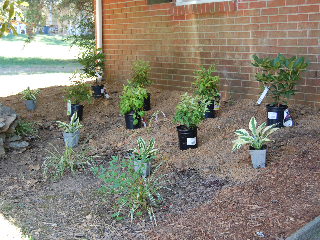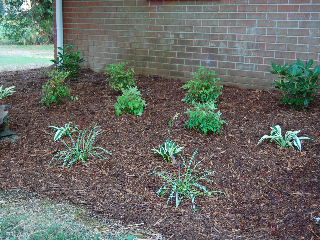
Set your plants on the ground before you set your plants in the ground.
Sounds pretty simple and it is, but failing to follow this simple rule can lead to some very unhappy and frustrated gardeners and to a whole lot more work than is necessary.
It’s like the old carpentry adage “measure twice, saw once.” If you plan carefully, you’re sure to make the best use of your time and materials, and you’ll end up pleased with your completed project.
Suppose you have in mind a landscaping project that is centered around the installation of a Japanese maple tree. You think you know exactly where you want the tree—just outside your front picture window so you’ll have a great view of it as you’re looking out from inside your living room.
You plant the tree with this goal in mind, only to realize that once you’re approaching the tree from the walkway in front of your house the balance is all wrong, your new tree conflicts with a nearby dogwood, and there’s nowhere left to make a balanced installation of the liriope and azaleas that you were counting on to finish out the project.
So, what should we do first? Go ahead and purchase and pose all the plants you visualize including in your proposed landscaping project. Set them on the ground in the exact locations and with the anticipated spacings and patterns you’re hoping for.
Now step back and look—and look—and look some more. By this I mean consider the view from all angles. If your plantings are at the front of the house, see how the layout appears when you’re looking straight at the house, when you’re standing beside the house looking across the front, and when you’re out in the yard or approaching from the sidewalk.
You may find that what looks nicely balanced and pleasing to the eye from one perspective appears completely lacking in symmetry and flow from another angle.

How do the colors and textures of the various plants blend together—do you need to mix them differently?
You may also decide that you actually have too many plants (or not enough) for the size of the area you are planting.
In addition, don’t forget to allow for growth as the plants mature.
Will they grow completely together in such a way that it will be difficult to work in the area in years to come doing such routine maintenance as pruning, fertilizing, and mulching?
If so, now is the time to space them out differently, before they have been planted into your landscape. And don’t be afraid to err on the side of too much open space rather than too little. If the bed is kept nicely groomed with mulch and is maintained free of weeds, the open and clean space between plants actually makes for a disciplined sense of harmony and flow in the overall landscape.
Plan before you plant; design before you dig.
 Set your plants on the ground before you set your plants in the ground.
Set your plants on the ground before you set your plants in the ground.
 How do the colors and textures of the various plants blend together—do you need to mix them differently?
How do the colors and textures of the various plants blend together—do you need to mix them differently?